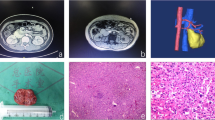Abstract
Pheochromocytoma is a tumor that originates from the adrenal cortex and sympathetic chains. Most pheochromocytomas are sporadic, whereas others occur as hereditary syndromes. Familial pheochromocytoma has been frequently found in association with various mutations in genes of the succinate dehydrogenase family. A 21-year-old Korean male presented with recurrent chest tightness, severe headache, and hypertension. He was diagnosed as pheochromocytoma based on a 24-hour urine test, abdominal computed tomography, and 131I-MIBG scintigraphy. Genomic DNA was extracted from the patient’s whole blood. Primers covering all the coding regions and flanking introns of succinate dehydrogenase (SDH) B, C and D genes were designed and synthesized, and a DNA sequence analysis was performed using the polymerase chain reaction. Direct sequencing of the SDHB gene revealed a deletion of nucleotide 757 (thymidine) in exon 7. This thymidine deletion caused a shift in the reading frame that created a downstream stop codon and a truncated product (p.Cys253ValfsX5). Although the patient had no family history of pheochromocytoma, his father had the same mutation. We report a novel SDHB gene mutation from a Korean family with pheochromocytoma. This is the first report of pheochromocytoma with a confirmed SDHB germline mutation in Korea.




Similar content being viewed by others
References
Pasini B, Stratakis CA (2009) SDH mutations in tumorigenesis and inherited endocrine tumours: lesson from the phaeochromocytoma-paraganglioma syndromes. J Intern Med 266(1):19–42
Bayley JP, Devilee P, Taschner PE (2005) The SDH mutation database: an online resource for succinate dehydrogenase sequence variants involved in pheochromocytoma, paraganglioma and mitochondrial complex II deficiency. BMC Med Genet 6:39
Leiden Open Variation Database A, Netherlands. http://chromium.liacs.nl/lovd_sdh/home.php?select_db=SDHB. Cited 25 May 2010
Bryant J, Farmer J, Kessler LJ et al (2003) Pheochromocytoma: the expanding genetic differential diagnosis. J Natl Cancer Inst 95(16):1196–1204
Neumann HP, Pawlu C, Peczkowska M et al (2004) Distinct clinical features of paraganglioma syndromes associated with SDHB and SDHD gene mutations. JAMA 292(8):943–951
Benn DE, Gimenez-Roqueplo AP, Reilly JR et al (2006) Clinical presentation and penetrance of pheochromocytoma/paraganglioma syndromes. J Clin Endocrinol Metab 91(3):827–836
Zarnegar R, Kebebew E, Duh QY et al (2006) Malignant pheochromocytoma. Surg Oncol Clin N Am 15(3):555–571
Solis DC, Burnichon N, Timmers HJ et al (2009) Penetrance and clinical consequences of a gross SDHB deletion in a large family. Clin Genet 75(4):354–363
Acknowledgments
We would like to thank professor Sang-Hyun Hwang for his kind advice.
Author information
Authors and Affiliations
Corresponding author
Rights and permissions
About this article
Cite this article
Lee, S.A., Kim, E.H., Lee, Y.M. et al. A novel mutation of the Succinate Dehydrogenase B Gene in a Korean Family with Pheochromocytoma. Familial Cancer 9, 643–646 (2010). https://doi.org/10.1007/s10689-010-9359-0
Published:
Issue Date:
DOI: https://doi.org/10.1007/s10689-010-9359-0




